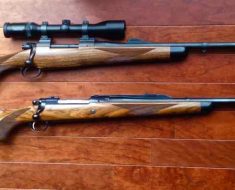“Effortless cylinder release for flawless performance.”
Proper Cleaning and Maintenance Techniques
Revolver enthusiasts know the importance of proper maintenance and cleaning to ensure smooth cylinder release operation. Neglecting these essential tasks can lead to malfunctions and decreased performance. In this article, we will discuss some techniques to help you keep your revolver in top condition.
First and foremost, it is crucial to regularly clean your revolver after each use. Residue from firing can build up in the cylinder, causing it to stick and impede the release mechanism. To clean the cylinder, remove it from the revolver and use a cleaning rod with a brass brush to scrub away any fouling. Be sure to use a solvent specifically designed for firearms to break down stubborn residue.
After cleaning the cylinder, it is important to lubricate it properly. A light coat of gun oil on the cylinder’s surface will help prevent corrosion and ensure smooth operation. Be sure to wipe away any excess oil to prevent it from attracting dirt and debris.
In addition to cleaning and lubricating the cylinder, it is also important to inspect the release mechanism regularly. Check for any signs of wear or damage, such as worn springs or broken components. If you notice any issues, it is best to have them repaired by a qualified gunsmith to prevent further damage.
Another important aspect of maintaining smooth cylinder release operation is to store your revolver properly. Keep it in a cool, dry place away from moisture and extreme temperatures. Moisture can cause rust to form on the cylinder, leading to sticking and malfunction. A gun safe or case is an ideal storage solution to protect your revolver from the elements.
Regularly inspecting your revolver for any signs of wear or damage is also crucial in ensuring smooth cylinder release operation. Look for any cracks, dents, or other abnormalities that could affect the revolver’s performance. If you notice any issues, have them addressed by a professional gunsmith to prevent further damage.
In conclusion, proper cleaning and maintenance techniques are essential for ensuring smooth cylinder release operation in revolvers. By regularly cleaning, lubricating, and inspecting your revolver, you can prevent malfunctions and keep it in top condition. Remember to store your revolver properly and address any issues promptly to maintain its performance. With these tips in mind, you can enjoy smooth and reliable operation from your revolver for years to come.
Choosing the Right Ammunition
When it comes to operating a revolver, one of the most important aspects to consider is the smooth release of the cylinder. This is crucial for ensuring that the revolver functions properly and reliably. One key factor that can impact the smoothness of the cylinder release operation is the type of ammunition being used. In this article, we will discuss the importance of choosing the right ammunition for your revolver to ensure smooth cylinder release operation.
First and foremost, it is essential to understand that not all ammunition is created equal. Different types of ammunition can have varying levels of pressure, which can affect how smoothly the cylinder releases. It is important to choose ammunition that is specifically designed for use in revolvers to ensure optimal performance.
One important consideration when choosing ammunition for your revolver is the overall length of the cartridge. Revolvers are designed to accommodate specific cartridge lengths, and using ammunition that is too long or too short can cause issues with the cylinder release. It is important to carefully check the specifications of your revolver to ensure that you are using the correct cartridge length.
In addition to cartridge length, it is also important to consider the type of bullet being used in the ammunition. Some bullets are designed with a flat or rounded nose, while others have a more pointed shape. The shape of the bullet can impact how smoothly the cylinder releases, so it is important to choose ammunition with a bullet shape that is compatible with your revolver.
Another important factor to consider when choosing ammunition for your revolver is the overall quality of the ammunition. Cheaper, lower-quality ammunition may not be manufactured to the same standards as higher-quality ammunition, which can lead to issues with the cylinder release. It is important to choose ammunition from reputable manufacturers to ensure that you are getting a reliable product.
When selecting ammunition for your revolver, it is also important to consider the type of powder being used. Different powders can produce varying levels of pressure, which can impact how smoothly the cylinder releases. It is important to choose ammunition with a powder load that is appropriate for your revolver to ensure optimal performance.
In conclusion, choosing the right ammunition for your revolver is crucial for ensuring smooth cylinder release operation. By considering factors such as cartridge length, bullet shape, overall quality, and powder type, you can help to ensure that your revolver functions properly and reliably. Taking the time to select the right ammunition for your revolver will not only improve the smoothness of the cylinder release operation but also enhance the overall performance of your firearm.
Understanding Cylinder Timing
Revolver enthusiasts know that proper cylinder timing is crucial for smooth and reliable operation. Understanding how cylinder timing works can help you diagnose and fix issues that may arise with your revolver. In this article, we will delve into the intricacies of cylinder timing and explore how you can ensure that your revolver’s cylinder release operation is as smooth as possible.
Cylinder timing refers to the precise alignment of the cylinder with the barrel and firing pin when the revolver is cocked and fired. When the hammer is cocked, the cylinder should rotate smoothly to align the next chamber with the barrel. If the cylinder timing is off, the revolver may misfire or fail to cycle properly.
One common issue that can affect cylinder timing is a worn or dirty hand. The hand is a small part inside the revolver that engages with the ratchet on the cylinder to rotate it when the hammer is cocked. If the hand is worn or dirty, it may not engage properly, leading to issues with cylinder timing.
To check the condition of the hand, remove the side plate of the revolver and inspect the hand for wear or debris. If the hand is worn, it may need to be replaced by a gunsmith. Cleaning the hand and the ratchet on the cylinder with a solvent and a brush can help improve their engagement and ensure smooth cylinder timing.
Another factor that can affect cylinder timing is the condition of the cylinder stop. The cylinder stop is a small part that locks the cylinder in place when the revolver is cocked. If the cylinder stop is worn or damaged, it may not engage properly, leading to issues with cylinder timing.
To check the condition of the cylinder stop, remove the side plate of the revolver and inspect the cylinder stop for wear or damage. If the cylinder stop is worn, it may need to be replaced by a gunsmith. Cleaning the cylinder stop and the corresponding notch on the cylinder with a solvent and a brush can help improve their engagement and ensure smooth cylinder timing.
In addition to checking and maintaining the hand and cylinder stop, it is also important to ensure that the cylinder is properly aligned with the barrel when the revolver is cocked. If the cylinder is not aligned correctly, the revolver may misfire or fail to cycle properly.
To check the alignment of the cylinder, cock the hammer and look down the barrel from the muzzle end. The cylinder should be perfectly aligned with the barrel, with no gap between them. If the cylinder is not aligned correctly, it may need to be adjusted by a gunsmith to ensure proper cylinder timing.
By understanding the importance of cylinder timing and knowing how to diagnose and fix issues that may arise, you can ensure that your revolver’s cylinder release operation is as smooth as possible. Regular maintenance and inspection of the hand, cylinder stop, and cylinder alignment can help prevent issues with cylinder timing and keep your revolver in top working condition. With proper care and attention, your revolver will continue to provide reliable performance for years to come.
Checking and Replacing Springs
Revolver enthusiasts know the importance of a smooth cylinder release operation. Whether you’re a seasoned shooter or a beginner, ensuring that your revolver functions properly is crucial for safety and performance. One key component that plays a significant role in the cylinder release operation is the springs. In this article, we will discuss how to check and replace the springs in your revolver to maintain optimal performance.
Before diving into the specifics of checking and replacing the springs, it’s essential to understand the role they play in the cylinder release operation. The springs in a revolver are responsible for providing the necessary tension and force to ensure that the cylinder rotates smoothly and locks into place securely. Over time, these springs can wear out or become damaged, leading to issues with the cylinder release operation.
To check the springs in your revolver, start by disassembling the firearm according to the manufacturer’s instructions. Once you have access to the internal components, carefully inspect the springs for any signs of wear, corrosion, or damage. Look for any coils that are stretched out, broken, or misshapen, as these are indicators that the springs need to be replaced.
If you notice any issues with the springs during your inspection, it’s crucial to replace them promptly to prevent any malfunctions or safety hazards. When replacing the springs, make sure to use high-quality replacement parts that are specifically designed for your revolver model. Using the wrong springs can lead to improper functioning and potentially dangerous situations.
When installing the new springs, pay close attention to the orientation and positioning of each spring. Improper installation can cause the springs to bind or fail to provide the necessary tension, resulting in a malfunctioning cylinder release operation. Take your time and follow the manufacturer’s instructions carefully to ensure that the springs are installed correctly.
After replacing the springs, it’s essential to test the cylinder release operation to ensure that everything is functioning as it should. Check for smooth and consistent rotation of the cylinder, as well as secure locking into place when closed. If you notice any issues or inconsistencies, double-check the installation of the springs and make any necessary adjustments.
Regular maintenance and inspection of the springs in your revolver are key to ensuring optimal performance and safety. By checking and replacing the springs as needed, you can prevent malfunctions and maintain a smooth cylinder release operation. Remember to use high-quality replacement parts and follow the manufacturer’s instructions carefully to ensure proper installation.
In conclusion, the springs in a revolver play a crucial role in the cylinder release operation. By checking and replacing the springs as needed, you can maintain optimal performance and safety. Remember to inspect the springs regularly for any signs of wear or damage, and replace them with high-quality parts when necessary. With proper maintenance and care, your revolver will continue to function smoothly for years to come.
Practicing Proper Grip and Technique
Revolver enthusiasts know that proper grip and technique are essential for ensuring smooth cylinder release operation. Whether you’re a seasoned shooter or a beginner, mastering the fundamentals of handling a revolver is crucial for safety and accuracy.
One of the first things to consider when practicing proper grip is hand placement. Your dominant hand should grip the revolver firmly, with your index finger resting on the trigger guard. Your non-dominant hand should support the grip, providing stability and control. Make sure your thumbs are positioned comfortably and avoid crossing them over the back of the revolver, as this can interfere with the cylinder release mechanism.
As you prepare to release the cylinder, it’s important to maintain a steady grip on the revolver. Avoid gripping too tightly, as this can cause fatigue and affect your accuracy. Instead, find a balance between firmness and flexibility, allowing for a smooth and controlled release.
When it comes time to release the cylinder, use your non-dominant hand to push the cylinder release latch forward. This action should be done with a quick and decisive motion, ensuring that the cylinder is released smoothly. Avoid hesitating or fumbling with the release latch, as this can lead to misfires or malfunctions.
Once the cylinder is released, use your non-dominant hand to push the cylinder out of the frame. Make sure to keep your fingers clear of the cylinder window to avoid any potential injuries. With a steady hand, rotate the cylinder out of the frame and inspect each chamber for any obstructions or debris.
After inspecting the chambers, it’s time to reload the revolver. Insert the rounds into the chambers, making sure they are seated properly and securely. Once the chambers are loaded, rotate the cylinder back into the frame and lock it into place. Your revolver is now ready to fire, thanks to your smooth and efficient cylinder release operation.
Practicing proper grip and technique is essential for revolver enthusiasts of all skill levels. By mastering the fundamentals of handling a revolver, you can ensure safety, accuracy, and reliability in every shooting session. Remember to always follow proper safety protocols and guidelines when handling firearms, and never hesitate to seek guidance from experienced shooters or instructors.
In conclusion, mastering the art of smooth cylinder release operation in revolvers requires practice, patience, and attention to detail. By focusing on proper grip and technique, you can enhance your shooting skills and enjoy a safe and rewarding shooting experience. So grab your revolver, hit the range, and put your skills to the test – you’ll be amazed at the difference proper grip and technique can make.





